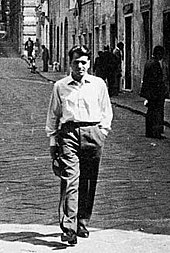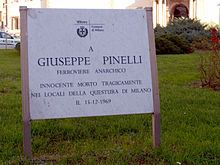Giuseppe Pinelli
You can help expand this article with text translated from the corresponding article in Italian. (January 2021) Click [show] for important translation instructions.
|
Giuseppe Pinelli | |
|---|---|
 Portrait of Giuseppe Pinelli | |
| Born | October 21, 1928 |
| Died | December 15, 1969 (aged 41) Milan, Italy |
| Cause of death | Defenestration |
| Nationality | Italian |
| Occupation | Railroad worker |
| Movement | Anarchism |


Giuseppe "Pino" Pinelli (21 October 1928 – 15 December 1969)[2] was an Italian railroad worker and anarchist, who died while being detained by the Polizia di Stato in 1969.[3] Pinelli was a member of the Milan-based anarchist association named Ponte della Ghisolfa. He was also the secretary of the Italian branch of the Anarchist Black Cross. His death, believed by many to have been caused by members of the police,[4] inspired Nobel Prize laureate Dario Fo to write his famous play titled Accidental Death of an Anarchist.[5]
Early life[edit]
Pinelli was born in Milan to Alfredo Pinelli and Rosa Malacarne.[2] His family was working-class in one of the poorest areas of post-World War I Milan. Although he had to work in many low-income jobs, such as waiter and warehouseman,[2] in order to make ends meet, he nonetheless found the time to read many books and become politically active throughout his youth.[2] Among other political activities, he also worked with the anarchist group which published the weekly paper Il Libertario.[3]
In 1954, he found work as a railroad fitter. In 1955, he married Licia Rognini, whom he had met at an evening class of Esperanto.[3] During the 1960s, he continued anarchist activism. He organized young anarchists in the Gioventù Libertaria (Libertarian Youth) in 1962.[2] He helped found the "Sacco and Vanzetti anarchist association" in 1965. He founded the Ponte della Ghisolfa association (named after the nearby bridge) in 1968.[2]
Suspicious circumstances surrounding his death[edit]
On 12 December 1969, a bomb exploded at the Piazza Fontana in Milan which killed 17 people and injured 88.[6] Pinelli was picked up, along with other anarchists, for questioning regarding the attack.[3] Just before midnight on 15 December 1969, Pinelli was seen to fall to his death from a fourth-floor window of the Milan police station.[7] Three police officers interrogating Pinelli, including Commissioner Luigi Calabresi, were put under investigation in 1971 for his death, but legal proceedings concluded it was due to accidental causes.[8]
Pinelli's name has since been cleared,[7] and the far-right Ordine Nuovo was accused of the 1969 Piazza Fontana bombing[6] (in 2001, three neo-fascists were convicted,[9] a sentence overturned in March 2004;[6] a fourth defendant, Carlo Digilio, was a suspected CIA informant who became a witness for the state and received immunity from prosecution).[9]
Calabresi was later killed by two shots from a revolver outside his home in 1972.[10] In 1988, former Lotta Continua leader Adriano Sofri was arrested with Ovidio Bompressi and Giorgio Pietrostefani for Calabresi's murder.[11] The charges against them were based on testimony provided, 16 years later, by Leonardo Marino, an ex-militant who confessed to the murder of Calabresi, under order from Adriano Sofri. Claiming his innocence, Sofri was finally convicted after a highly contentious trial, in 1997.[12]
In popular culture[edit]
Pinelli's death is the inspiration for:
- Dario Fo's play Accidental Death of an Anarchist, although in the original script, his name was not mentioned explicitly.[3]
- The painting Funeral of the Anarchist Pinelli by Italian artist Enrico Baj.[3]
- The political documentary film 12 dicembre (1972) directed by Giovanni Bonfanti and based on an idea by Pier Paolo Pasolini.[13]
- The song Ballata per l'Anarchico Pinelli.[14]
- The popular song La ballata del Pinelli.[15]
- The movie Piazza Fontana: The Italian Conspiracy: Pinelli was portrayed by Pierfrancesco Favino.
Hints of his death are also in the songs Asilo 'Republic' by Vasco Rossi and Quarant'anni by the Modena City Ramblers.
See also[edit]
Notes[edit]
- ^ Italian justice has used a system of [state witnesses] "collaboratori di giustizia-collaborators with justice" to fight against terrorism and the mafia.
References[edit]
- ^ Foot, John (2014), "Divided Memories in Italy. Stories from the Twentieth and Twenty-first Centuries", in Hannes Obermair; et al. (eds.), Erinnerungskulturen des 20. Jahrhunderts im Vergleich – Culture della memoria del Novecento al confronto, Hefte zur Bozner Stadtgeschichte/Quaderni di storia cittadina, vol. 7, Bozen-Bolzano: City of Bozen-Bolzano, pp. 182–185, ISBN 978-88-907060-9-7
- ^ a b c d e f "Giuseppe 'Pino' Pinelli (1928-1969): the 17th victim of the Piazza Fontana bombing". Kate Sharpley Library.
- ^ a b c d e f "Pinelli, Giuseppe 'Pino', 1928-1969". Libcom.org. 9 November 2006.
- ^ "Italy from the 1960s". Encyclopædia Britannica. Retrieved 17 July 2011.
- ^ Fleury, Matthew (1985). "Dario Fo". Bomb Magazine, New Art Publications. Retrieved 5 March 2013.
The events upon which the play is based took place in 1969. A bomb exploded in the center of Milan, near the Duomo. Sixteen died. The police blamed the anarchists, one of whom, Giovanni Pinelli, they seized. Later on he was thrown from a window at police headquarters. There is considerable evidence that Pinelli's death was murder, not an accident as the police claimed, so the title Accidental Death of an Anarchist, is ironic. We are sure it was not an accident . . . . It was murder . . . . But this is the official police characterization of the event. The case was filed as an 'accidental death'.
- ^ a b c "1969: Deadly bomb blasts in Italy". BBC. 12 December 1969.
- ^ a b Bohlen, Celestine (26 September 1997). "Dispute in Italy Is Conjuring Up Its Terrorist Past". The New York Times. p. 2. Retrieved 5 April 2009.
- ^ "Né omicidio né suicidio: Pinelli cadde perché colto da malore". La Stampa. 29 October 1975.
- ^ a b "Three jailed for 1969 Milan bomb". The Guardian. 1 July 2001. Retrieved 16 January 2015.
- ^ "Assassinato per strada il commissario Calabresi". La Stampa. 17 May 1972.
- ^ Sasso, Cinzia (1 August 1988). "UN 'CASSIERE' RACCOGLIEVA ARMI E DENARO DELLE RAPINE". la Repubblica. Retrieved 17 January 2014.
- ^ Foschini, Paolo (23 January 1997). "Definitive le condanne per Sofri e gli altri". Corriere della Sera. Retrieved 17 January 2014.
- ^ "12 dicembre". IMDb.
- ^ Nawrocki, Norman (2013). Cazzarola!: Anarchy, Romani, Love, Italy (A Novel). PM Press. p. 172. ISBN 9781604863154.
- ^ "La ballata del Pinelli". antiwar songs.
External links[edit]
- La ballata del Pinelli (The ballad of Pinelli) – in Italian
- 2001 Conviction of the bombers Archived 16 January 2007 at the Wayback Machine
- Giuseppe Pinelli Page Daily Bleed's Anarchist Encyclopedia
